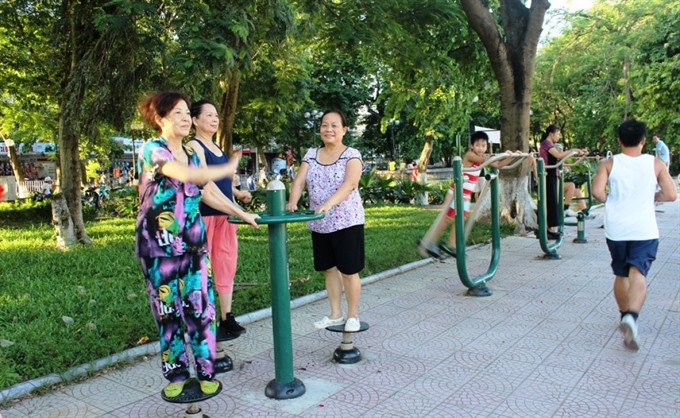Hà Nội suburbs await outdoor gyms, playgrounds
 |
| Residents do morning exercises with outdoor sports equipment at the Thống Nhất Park in Hà Nội. - Photo hanoimoi.com.vn |
The free outdoor gyms that began springing up three years ago have proved very popular with residents, prompting more people to exercise regularly.
Đinh Văn Luyến, Head of Public Sports Division under the city’s Department of Culture and Sports, said that between 2014 and 2016, exercise equipment was installed in the seven districts of Long Biên, Ba Đình, Tây Hồ, Hà Đông, Thanh Xuân, Hai Bà Trưng and Cầu Giấy.
“The free outdoor gyms have been welcomed and applauded. Previously, people usually went to the parks to walk, jog or do a few stretching exercise. Now they can do more with the supporting exercise equipment,” Luyến said.
The outdoor gyms have not only been funded by the city’s budget, but also with financial assistance from district budgets or private donors.
In May, the Tây Hồ District People’s Committee inaugurated two free outdoor gyms worth about VNĐ1 billion in its Thụy Khuê and Bưởi wards.
Tây Hồ Vice Chairman Phạm Xuân Tài said that district wanted to provide free exercise equipment to all eight wards in the district to promote sports and improve public health.
The district authority has called on private sector to join developing such gyms that beneficiaries would be responsible to manage and maintain, Tài said.
To some extent, the free outdoor gyms have helped meet demand for public sports facilities of people in crowded inner districts.
However, little of this change has made it to suburban areas in Hà Nội.
Nguyễn Văn Hạnh, a mechanic from Phú Xuyên district – a suburban district of Hà Nội, said that he lived and worked in Bưởi Ward, Tây Hồ District.
“I tried the exercise equipment. I saw many people interested in doing exercises around West Lake and some parks in Cầu Giấy District,” he said, adding that he wished such equipment would soon be available in his hometown.
“I’m sure that if the equipment is installed in the ground of the Community House in my hamlet, many people will begin exercising,” Hạnh said.
At a meeting of culture and sports officials in Hà Nội last year, director of the Mỹ Đức District Sports Centre, Nguyễn Thị Thuyên, said that suburban districts faced difficulties in providing free outdoor gyms because they had modest budgets.
“It is also more difficult for suburban districts to call for financial support from the private sector,” she said.
In June, the city’s Culture and Sports Department proposed to the People’s Committee that six new free outdoor gyms are opened this year in the districts of Đống Đa, Tây Hồ, Nam Từ Liêm, Ứng Hòa, Đan Phượng and Quốc Oai.
Between 2018 and 2020, the city plans to expand such gyms to other districts in the city, mostly suburban ones.
This is part of the city’s sport development plant until 2020 with vision towards 2030, which targets all communes and wards (except those in four inner districts of Hoàn Kiếm, Ba Đình, Đống Đa and Hai Bà Trưng) having sports facilities including a stadium, a gymnasium, a swimming pool and a playground.
Every hamlet in communes will have a community house combined with a sports ground, the plan says.
The plan was developed in light of the Law on Sports and a Government decision No112/2007/NĐ-CP clarifying some provisions of the law.
However, regulations on developing public sport facilities continue to be general and vague, said National Assembly deputy Ngọ Duy Hiểu.
The law states that People’s Committees at all levels are responsible for building public sports facilities. The Government’s decision stated that the People’s Committees should ensure resources including funding for public sports facilities.
"Both the law and the decision are too general, not specifying what the actual responsibilities are at various levels," Hiểu said.
Such ambiguity could lead to overlapping or ignoring of responsibilities by administrations at different levels, he added.
In Mễ Trì Ward of Nam Từ Liêm District, a project to build a Culture and Sports Centre was approved in 2007 and about 5,000sq.m of land allotted for it. But the centre has not been built so far.
The ward has 15 residential groups, but only seven have community houses and public playgrounds for sports or exercises.
Deputy director of the district’s Culture and Sport Centre, Nguyễn Thị Nga, said that other wards in the district did not have public playgrounds, despite the fact that land was available.
“Specific regulations, at least on funding, are needed to speed up the projects,” she said.
Ngô Văn Quý, Vice Chairman of the Hà Nội People’s Committee, said detailed information such as the number and the minimum area of public playgrounds in a hamlet had to be compiled to implement and actualise such projects.
What the stars mean:
★ Poor ★ ★ Promising ★★★ Good ★★★★ Very good ★★★★★ Exceptional
Latest News
More News
- Protect what’s next: towards a future free from meningococcal group B disease (December 05, 2025 | 18:00)
- New ILO report offers policy recommendations for disability inclusion (December 04, 2025 | 15:18)
- Maternal job loss may affect children’s mental health, research shows (December 03, 2025 | 19:11)
- Women lead Vietnam’s shift to climate-resilient agriculture (December 03, 2025 | 19:10)
- Experts highlight unpaid care work as key barrier to gender equality (December 03, 2025 | 15:15)
- Opportunities and inequalities for women workers in Vietnam's garment industry (December 03, 2025 | 09:00)
- Vietjet flights carry love to devastated central region (November 28, 2025 | 11:35)
- New initiative to boost the fight against domestic violence (November 26, 2025 | 10:00)
- South Korea funds IOM relief for Vietnam’s typhoon-affected communities (November 24, 2025 | 15:33)
- AI and human-centred values set to shape the future of HR in Vietnam (November 21, 2025 | 18:04)

















 Mobile Version
Mobile Version